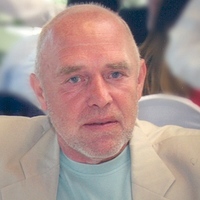
Peter Nicolaus
Dr. Peter Nicolaus is a retired United Nations official. As a Diplomat and Representative for the United Nations High Commissioner for Refugees (UNHCR) he worked in various countries.
During his humanitarian missions, Dr. Nicolaus continuously maintained both a private and professional relationship with the Yezidi communities in Northern Iraq, Armenia, Georgia and Germany, and has acquired extensive insight into their culture and religion.
Whilst posted in Northern Pakistan and Afghanistan he developed an interest in the shamanistic practices of the Muslim (Ismaili) population of Badakhshan and Kashmir. Through private travels to Northern India he was able to compare the belief system and rites of the Ismaili Shin with that of their Buddhist kinsmen in Ladakh.
In Myanmar, he mainly dealt with the return of Muslim refugees (Rohingya) from Bangladesh; while during his time in Germany, he became an expert in German and international refugee law (he published two books and numerous articles on German refugee law).
The opinions expressed in his articles are solely his own, and do not necessarily reflect those of the UN or UNHCR.
During his humanitarian missions, Dr. Nicolaus continuously maintained both a private and professional relationship with the Yezidi communities in Northern Iraq, Armenia, Georgia and Germany, and has acquired extensive insight into their culture and religion.
Whilst posted in Northern Pakistan and Afghanistan he developed an interest in the shamanistic practices of the Muslim (Ismaili) population of Badakhshan and Kashmir. Through private travels to Northern India he was able to compare the belief system and rites of the Ismaili Shin with that of their Buddhist kinsmen in Ladakh.
In Myanmar, he mainly dealt with the return of Muslim refugees (Rohingya) from Bangladesh; while during his time in Germany, he became an expert in German and international refugee law (he published two books and numerous articles on German refugee law).
The opinions expressed in his articles are solely his own, and do not necessarily reflect those of the UN or UNHCR.
less
Related Authors
Artur Rodziewicz
University of Warsaw
Berivan Can
Adana Bilim ve Teknoloji Üniversitesi
Oral Orpak
Istanbul University
Oral Orpak
Maria Curie - Skłodowska University
Christine Robins (nee Allison)
University of Exeter
Martin van Bruinessen
Universiteit Utrecht
Joanna Bocheńska
Jagiellonian University
S. Behnaz Hosseini
University of Victoria
Büşra Ersoy
Ankara Yildirim Beyazit University
Interests









Uploads
Books by Peter Nicolaus
Articles by Peter Nicolaus
briefly outlines its roots in ancient Mesopotamian religions, Judaism, Christianity, and Islam. Furthermore, it highlights the link between 72 nations and 72 genocides in Yezidi perception.
The Federal Administrative Court of Germany adopted the views expressed in the article and ruled that Palestinian refugees have a claim to be recognized as refugees on the basis of Art. 1 D of the 1951 Refugee Convention (decision 04.06.1991 – BverwG 1 C 42.88 -
https://www.jurion.de/urteile/bverwg/1991-06-04/bverwg-1-c-4288/?q=BVerwG+1+C+42.88+04.06.1991&sort=1)
about them. The latter holds, in particular, true with regard to the so-called Moskovisanjaq. Before World War I it was sent to the Russian Empire (East Anatolia and the Transcaucasus) every year, but was reported lost in 1914. Based on numerous interviews with Yezidis in Armenia, as well as on official correspondence between British, Iraqi, and Soviet authorities, the first part of the article reconstructs the odyssey of the Moskovi-sanjaq and the seven priests (qewwals) carrying it. It confirms that after 16 years of wandering through the Transcaucasus, five of the seven qewwals were eventually able to return via Odessa and London to the Yezidi heartland in Northern Iraq, but concludes that the Moskovi-sanjaq was ultimately lost in Georgia confiscated by the Soviet authorities.
The second part of the paper describes the history of a second sanjaq, which the author discovered in a village near Yerevan, secretly kept and protected from the prying eyes of non-Yezidis by a sheikhly family. Although all tales and myths, explaining how this second sanjaq arrived in Armenia, are examined and analysed, the origin of that sacred image remains mysterious. The article further paints a detailed picture of the cult, which evolved around the sacred image in Armenia as well as of the sometimes savage fights over its possession and the struggle of the keepers of the sanjaq with the Soviet authorities. In addition to interviews with eyewitnesses, the author bases his findings on court decisions and minutes of the councils of Yezidi elders, as well as information found at Yezidi graveyards.
Book Reviews by Peter Nicolaus
Mimeo by Peter Nicolaus
briefly outlines its roots in ancient Mesopotamian religions, Judaism, Christianity, and Islam. Furthermore, it highlights the link between 72 nations and 72 genocides in Yezidi perception.
The Federal Administrative Court of Germany adopted the views expressed in the article and ruled that Palestinian refugees have a claim to be recognized as refugees on the basis of Art. 1 D of the 1951 Refugee Convention (decision 04.06.1991 – BverwG 1 C 42.88 -
https://www.jurion.de/urteile/bverwg/1991-06-04/bverwg-1-c-4288/?q=BVerwG+1+C+42.88+04.06.1991&sort=1)
about them. The latter holds, in particular, true with regard to the so-called Moskovisanjaq. Before World War I it was sent to the Russian Empire (East Anatolia and the Transcaucasus) every year, but was reported lost in 1914. Based on numerous interviews with Yezidis in Armenia, as well as on official correspondence between British, Iraqi, and Soviet authorities, the first part of the article reconstructs the odyssey of the Moskovi-sanjaq and the seven priests (qewwals) carrying it. It confirms that after 16 years of wandering through the Transcaucasus, five of the seven qewwals were eventually able to return via Odessa and London to the Yezidi heartland in Northern Iraq, but concludes that the Moskovi-sanjaq was ultimately lost in Georgia confiscated by the Soviet authorities.
The second part of the paper describes the history of a second sanjaq, which the author discovered in a village near Yerevan, secretly kept and protected from the prying eyes of non-Yezidis by a sheikhly family. Although all tales and myths, explaining how this second sanjaq arrived in Armenia, are examined and analysed, the origin of that sacred image remains mysterious. The article further paints a detailed picture of the cult, which evolved around the sacred image in Armenia as well as of the sometimes savage fights over its possession and the struggle of the keepers of the sanjaq with the Soviet authorities. In addition to interviews with eyewitnesses, the author bases his findings on court decisions and minutes of the councils of Yezidi elders, as well as information found at Yezidi graveyards.